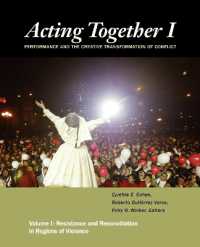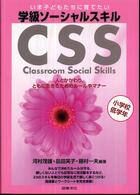- ホーム
- > 洋書
- > 英文書
- > Architecture
Full Description
Advanced Research and Design Tools for Architectural Heritage: Unforeseen Paths rethinks how to analyse, preserve, and adapt Architectural Heritage and its surroundings along unforeseen paths using a broad spectrum of advanced research and design tools. By delving into conceptual foundations and recent applications, it transcends disciplinary boundaries and leverages advanced design tools, such as space syntax, natural language processing, advanced photogrammetry, heritage building information modelling, and virtual reality.
This book offers a comprehensive collection of collaborative research studies by a team of scholars with diverse perspectives and digital expertise from long-term projects. Encompassing case studies and recent academic experiences, the volume explores notable heritage sites in Europe, Asia, and Africa. Readers are afforded a nuanced understanding of integrated tools through a forward-looking approach. By addressing critical heritage challenges, the book contributes to reshaping architecture discourse and practice.
The chapters explore the integration of advanced methodologies to address emerging societal concerns, making the book a valuable resource for architecture, archaeology, urban planning, catering to professors, trainers, and students. Additionally, its relevance extends to practitioners interested in cultural studies, urban policies, and data science, including archivists, representatives from public governmental authorities, and policy stakeholders.
Contents
List of figures
List of tables
List of contributors
Preface
Acknowledgements
Disclaimer
1. Introduction: Unforeseen Paths towards impactful heritage-based actions
Stefania Stellacci, Chiara Piccoli, Danilo Giglitto
2. Locating 'everyday' heritage in 20th-century residential developments on the sites of demolished English country houses: a space-syntactic archaeology of place
Sam Griffiths
3. The role of urban form and architectural heritage in the 'reurbanisation' of the historical centre of Nicosia
Ilaria Geddes
4. Inclusive design to overcome isolation: space syntax analysis and the road network of São Tomé
Rafael Abu-Raya, Sara Eloy
5. Re-thinking and re-imagining the value of the built heritage in a digital age
Richard Laing
6. Heritage sites as shared space of virtual communities: Participatory mapping through sentiment analysis
Stefania Stellacci, Sérgio Moro
7. Heritage Urban Transect for computational analysis of place vulnerability: Exploring historical waterscape connectivity in Mardin
Serdar Aydin, Izzettin Kutlu, Deryanur Simsek, Berat Celebioglu
8. Subak Syntax: Decoding the hydrological socio-agricultural systems of the Bali Subak Typology
James Melsom
9. A review of Non-Destructive Techniques and modelling methods for survey and condition monitoring on Architectural Heritage
Sara Gonizzi Barsanti, Rosa De Finis, Chiara Bertolin
10. Lost and Found in Translation: Integrating architectural surveys and computational models for Seljuk madrasas
Sena Kayasü, Sevgi Altun, Berkay Öztürk, Yusuf Şahin, Gözde Unal, Mine Özkar
11. Tackling the information gap: Comprehensive scientific documentation of virtual reconstructions
Bob Martens, Herbert Peter
12. Visiting the ghosts of mediaeval Silves: Virtual Reality experience of 3D urban reconstruction of the past
Rui Filipe Antunes
13. The importance of training architecture students in Scan-to-BIM and HBIM for enhanced preparedness and market competitiveness
Gabriella Del Duca
Index








